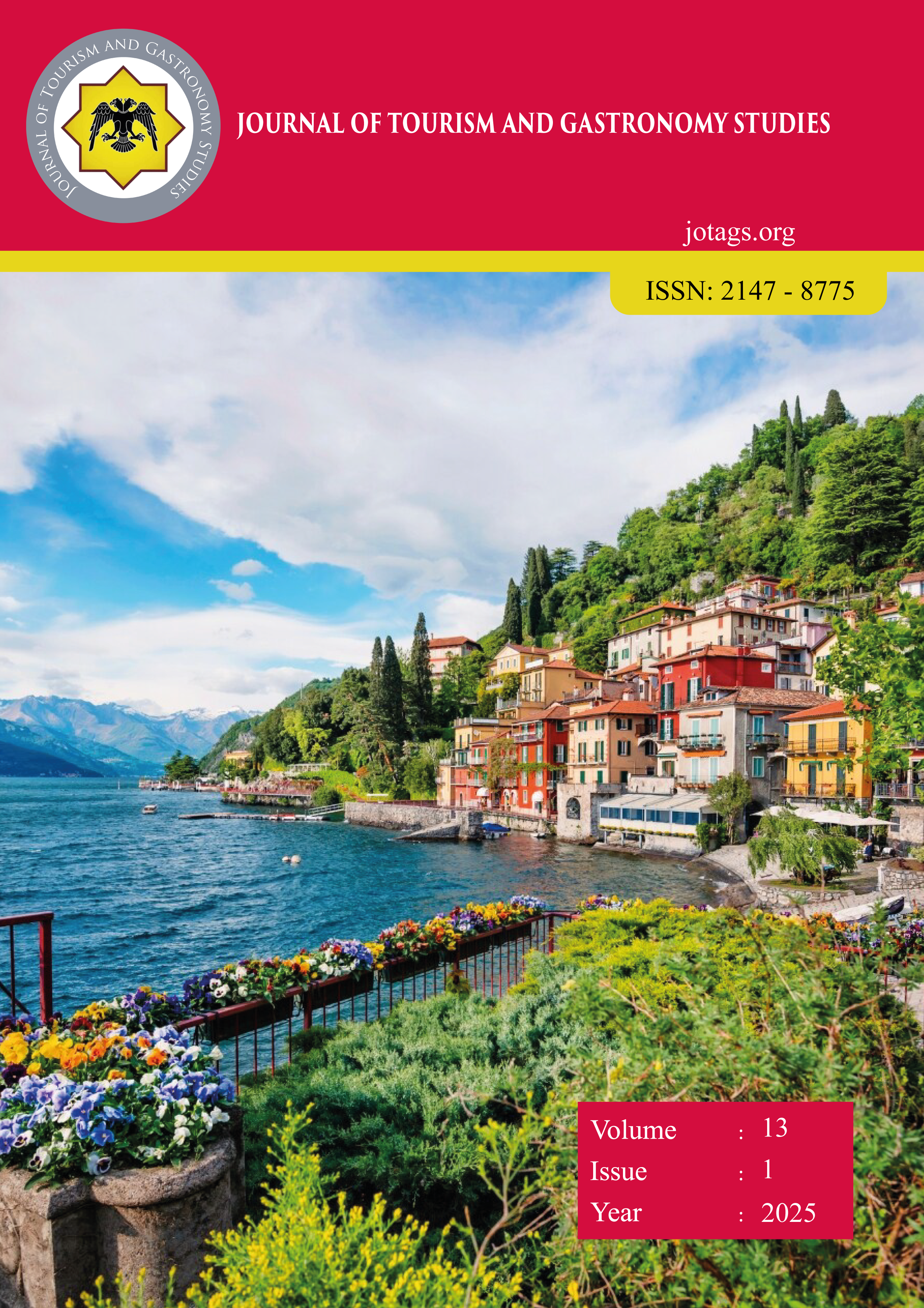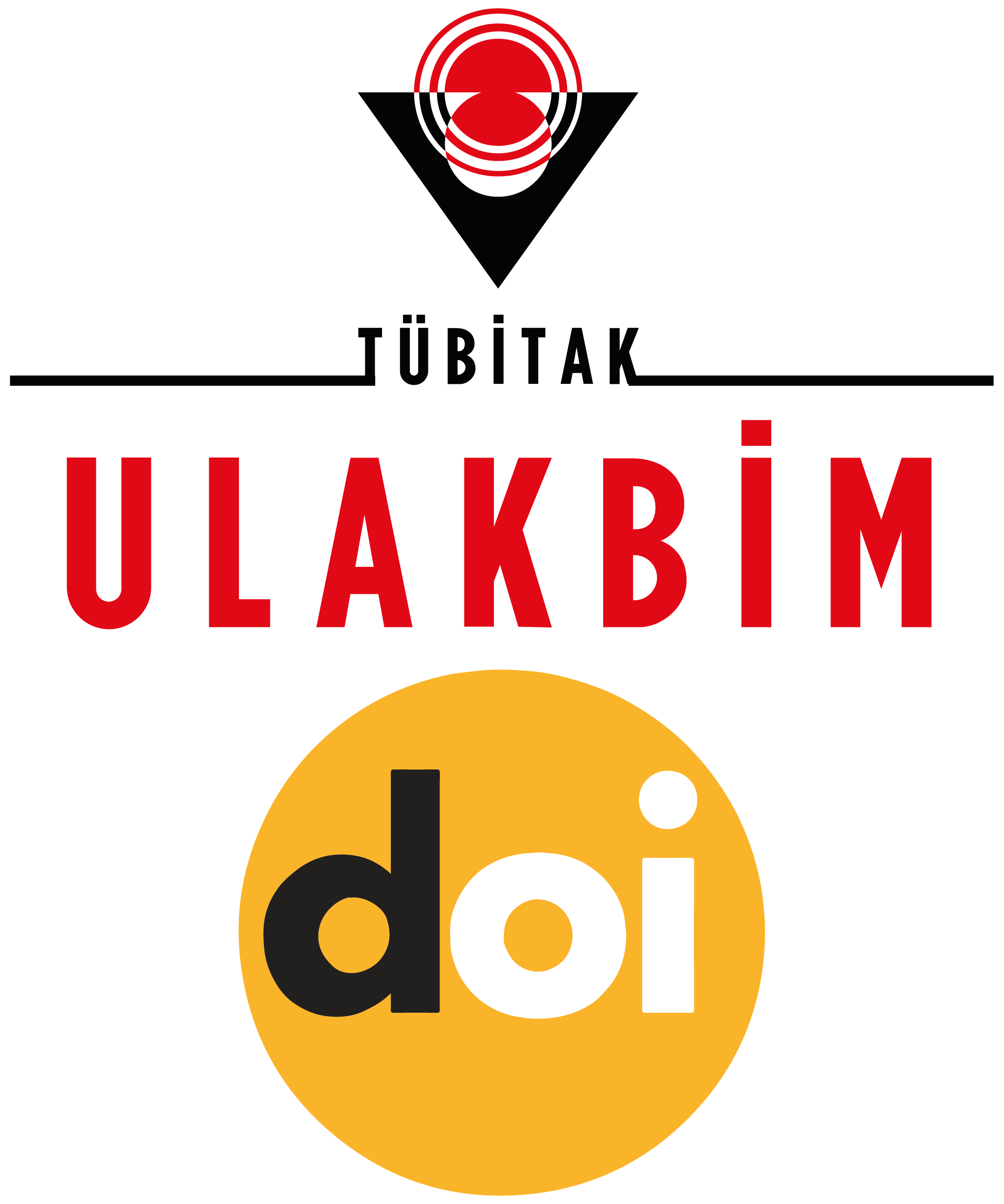Yönetsel Güç ve Dijital Liderliğin İç Girişimciliğe Etkisi (The Impact of Managerial Power and Digital Leadership on Intrapreneurship)
DOI:
https://doi.org/10.21325/jotags.2025.1588Keywords:
Digital leadership, Intrapreneurship, Tourism and hotel businesses, Managerial powerAbstract
The entrepreneurial behavior of employees is an important factor that determines the competitiveness, success and sustainability of hotel businesses. Managers play an important role in the workforce exhibiting such behaviors. In this context, the aim of the study is to determine the effects of digital leadership behaviors and managerial power usage of hotel business managers on the intrapreneurial behaviors of employees. The study was conducted with a causal scanning design, one of the quantitative research methods. The research universe consists of hotel employees operating in Istanbul. In order to ensure that the participants represent the universe more, “stratified sampling” and "easy sampling" techniques were used. The research data were collected from 947 hotel employees in 42 different hotels with the survey technique. As a result of the study, it was determined that position power, one of the managerial power dimensions, had a negative and significant effect on the intrapreneurial performance of hotel business employees. No significant effect was observed on the intrapreneurial performance of other managerial power dimensions and digital leadership. However, it was determined that digital leadership did not produce any significant effect on intrapreneurial behavior.
References
Avolio, B. J., Kahai, S., & Dodge, G. E. (2000). E-leadership: implications for theory, research, and practice. The Leadership Quarterly, 11(4), 615-668.
Bakar, M. S., Mahmood, R., & Lucky, E. O. I. (2015). The mediating role of intrapreneurial orientation between leadership style, knowledge sharing behaviour and performance of Malaysian academic leaders: A conceptual framework. Sains Humanika, 4(1).
Başar, M., & Tosunoğlu, B. T. (2006). Değer yaratımında iç girişimciliğin değişen boyutu: Bilgi girişimcilerinin rolü. Girişimcilik ve Kalkınma Dergisi.
Bosma, N. S., Stam, F. C., & Wennekers, A. R. M. (2010). Intrapreneurship: An international study. Scientific Analysis of Entrepreneurship and SMEs, Zoetermeer, 12,1–29.
Büyükyılmaz, O., & Kayış, M. (2018). Dönüştürücü liderliğin iç girişimcilik davranışına etkisi: Bolu ilinde bir araştırma. Bolu Abant İzzet Baysal Üniversitesi Sosyal Bilimler Enstitüsü Dergisi, 18(3), 147-167.
Coşkun, R., Altunışık, R., Bayraktaroğlu, S., & Yıldırım, E. (2015). Sosyal Bilimlerde Araştırma Yöntemleri: Spss Uygulamalı. 8. Baskı. Sakarya: Sakarya Yayıncılık.
Felicio, J. A., Rodrigues, R., & Caldeirinha, V. R. (2012). The effect of intrapreneurship on corporate performance. Management Decision, 50(10), 1717-1738.
French, J. R. P., & B. H. Raven. (1959). The Bases of Social Power. D. Cartwright ve A. Zander (Ed.). Studies in social power İçinde. 3rd Edition. Ann Arbor, Michigan: Research Center for Group Dynamics, Institute for Social Research, University of Michigan, 259-269.
Güven, B. (2019). The integration of strategic management and intrapreneurship: Strategic intrapreneurship from theory to practice. Business and Economics Research Journal. 11(1), 229-245.
Hair, J. F., Black, W. C., Babin, B. J., Anderson, R. E., & Tatham, R. L. (2006). Multivariate Data Analysis. 6th edition. Upper Saddle River, NJ: Pearson University Press.
Harris, O. J. & Hartman, S. J. (2002). Organizational Behavior. Psychology Press.
Hornsby, J. S., Kuratko, D. F., & Zahra, S. A. (2002). Middle managers' perception of the internal environment for corporate entrepreneurship: Assessing a measurement scale. Journal of Business Venturing, 17(3), 253-273.
Hornsby, J. S., Kuratko, D. F., Shepherd, D. A., & Bott, J.P. (2009). Managers’ corporate entrepreneurial actions: Examining perception and position. Journal of Business Venturing, 24, 236–247.
İslamoğlu, A. H. (2009). Sosyal Bilimlerde Araştırma Yöntemleri: Spss Uygulamalı. İzmit: Beta Basım Yayım Dağıtım.
Jong, I., & Hartog, D. (2007). How leaders influence employees innovative behavior? European Journal of Innovation Management, 10(1), 41-64.
Kabadayı, M. (2018) Yönetsel Gücün Örgütsel Güven-Performans ve Özdeşleşme Etkileşimi Kapsamındaki Rolü: Bodrum’daki Otel İşletmelerinde Bir Uygulama. Yayımlanmamış Yüksek Lisans Tezi, Sakarya Üniversitesi, Sosyal Bilimler Enstitüsü, Sakarya.
Kabadayı, M. & Türkay, O. (2020). Yönetsel gücün örgütsel güven-performans ve özdeşleşme etkileşimi kapsamındaki rolü: Bodrum'daki otel işletmelerinde bir uygulama. Yönetim Bilimleri Dergisi, 18(35), 111-139.
Kalaycı, Ş. (2016). SPSS Uygulamalı Çok Değişkenli İstatistik Teknikleri. Ankara: Asil Yayın Dağıtım.
Kane, G. C., Palmer, D., Phillips, A. N., Kiron, D., & Buckley, N. (2019). Strategy, not technology, drives digital transformation. MIT Sloan Management Review and Deloitte University Press, 14 (1-25).
Kayış, M. (2017). Etkileşimci ve Dönüştürücü Liderliğin İç Girişimcilik Davranışına Etkisi, Yayımlanmamış Yüksek Lisans Tezi. Karabük Üniversitesi, Sosyal Bilimler Enstitüsü.
Kim, J., & Park, K. (2018). Relations between intrapreneurship and emotional intelligence, supportive leadership and adaptation performance in organization. Journal of Digital Convergence, 16(11), 289-301.
Kreutzer, R. T., Neugebauer, T., & Pattloch, A. (2017). Digital Business Leadership. Digital Transformation Geschäftsmodell İnnovation Agile Organisation Change Management. Springer Gabler, Wiesbaden, pp. 43-212.
Li, W., Liu, K., Belitski, M., Ghobadian, A., & O'Regan, N. (2016). E-leadership through strategic alignment: An empirical study of small-and medium-sized enterprises in the digital age. Journal of Information Technology, 31(2), 185-206.
Lin, M., Ling, Q., Luo, Z., & Wu, X. (2019). Why does empowering leadership occur and matter? A multilevel study of chinese hotels. Tourism Management Perspectives, 32, 100556.
Liu, C. H. S., & Huang, Y. C. (2020). The influence of transformational leadership on subordinate creative behaviour development process. Tourism Management Perspectives, 36, 100742.
Mahbobkhah, F. (2019). The effect of managers’ power on employees’ entrepreneurship: an empirical study in the public offices of Iran. Brazilian Journal of Operations & Production Management, 16(4), 617-626.
Mihardjo, L. W. W., Sasmoko, S., Alamsjah, F., & Elidjen, E. (2019). Digital leadership role in developing business model innovation and customer experience orientation in industry 4.0. Management Science Letters, 9(11), 1749-1762.
Mittal, S., & Dhar, R. L. (2015). Transformational leadership and employee creativity: Mediating role of creative self-efficacy and moderating role of knowledge sharing. Management Decision, 53(5), 894-910.
Moriano, J. A., Molero, F., Topa, G., & Lévy Mangin, J. P. (2011). The influence of transformational leadership and organizational identification on intrapreneurship. International Entrepreneurship and Management Journal, 10(1), 103-119.
Narbona, J. (2016). Digital leadership, twitter and Pope Francis. Church, Communication and Culture, 1(1), 90-109.
Neessen, P., Caniels, M. C., Vos, B., & De Jong, J. P. (2019). The intrapreneurial employee: toward an integrated model of intrapreneurship and research agenda. International Entrepreneurship and Management Journal, 15(2), 545-571.
Oberer, B., & Erkollar, A. (2018). Leadership 4.0: Digital leaders in the age of industry 4.0. International Journal of Organizational Leadership, 7(4), 404-412.
Oğuzlar, A. (2003). Veri ön işleme. Erciyes Üniversitesi İktisadi ve İdari Bilimler Fakültesi Dergisi. 21, 67-76.
Öztürk, E. (2005). Çoklu Doğrusal Regresyon Modeli. Ş. Kalaycı (Ed.). SPSS uygulamalı çok değişkenli istatistik teknikleri İçinde. Ankara: Asil Yayın Dağıtım, 259-272.
Pearce, C. L., & Sims, H. P. (2002), The relative ınfluence of vertical vs. shared leadership on the longitudinal effectiveness of change management teams. Group Dynamics: Theory, Research, and Practice, 6(2), 172-197.
Pesonen, J. (2020). Management and leadership for digital transformation in tourism. Handbook of e-Tourism, 1-34.
Peter, J. P. (1979). Reliability: A review of psyhometric basics and recent marketing practices. Journal of Marketing Research, 16 (1), 6-17.
Peyton, T., Zigarmi, D., & Fowler, S.N. (2019). Examining the relationship between leaders' power use, followers' motivational outlooks, and followers' work ıntentions. Frontiers in Psychology, 9, 2620.
Pfeffer, J. (1992). Managing with Power: Politics and İnfluence in Organizations. Boston: Harvard Business School Press.
Pieterse, A. N., Van Knippenberg, D., Schippers, M., & Stam, D. (2010). Transformational and transactional leadership and ınnovative behavior: The moderating role of psychological empowerment. Journal of Organizational Behavior, 31(4), 609-623.
Podsakoff, P. M., & Schriescheim, C. A. (1985). Field studies of French and Raven's bases of power: critique, reanalysis, and suggestions for future research. Psychological Bulletin, 97(387–41), 1.
Prince, K. A. (2017, December). Industrie 4.0 and leadership. in Proceedings of the 17th International Conference on Electronic Business (pp. 132-139).
Rahim, M. A. (1988). The development of a leader power ınventory. Multivariate Behavioral Research. 23(4), 491-503.
Rahim, M. A. (1989). Relationships of leader power to compliance and satisfaction with supervision: Evidence from a national sample of managers. Journal of Management, 15(4), 545-556.
Randolph, W. A., & Kemery, E. R. (2011). Managerial use of power bases in a model of managerial empowerment practices and employee psychological empowerment. Journal of Leadership & Organizational Studies, 18(1), 95-106.
Raven, B. H. (1993). The bases of power: origins and recent Developments. Journal of Social Issues, 49(4), 227-251.
Roman, A. V., Van Wart, M., Wang, X., Liu, C., Kim, S., & McCarthy, A. (2019). Defining e‐leadership as competence in ICT‐mediated communications: an exploratory assessment. Public Administration Review, 79(6), 853-866.
Salancik, G. R., & Pfeffer, J. (1977). Who gets power—and how they hold on to ıt: A strategic-contingency model of power. Organizational Dynamics, 5(3), 3-21.
Schermerhorn, J. R., Hunt, J. G., & Osborn, R. N. (2002). Organizational Behavior. New York: John Wiley & Sons, Inc.
Schumpeter, J. A. (1934). The Theory of Economic Development. New Brunswick, NJ: Transaction Publishers.
Sekaran, U. (1992). Research Methods for Business: A Skill Building Approach. New York: John Wiley, And Sons.
Sezgin, O. B. (2020). İçgirişimci davranışı: ölçek geliştirme, güvenilirlik ve geçerlilik çalışması. Uluslararası İktisadi ve İdari İncelemeler Dergisi, (26), 249-268.
Stull, M. (2005). Intrapreneurship in nonprofit organizations examining the factors that facilitate entrepreneurial behaviour among employees. Retrieved May, 24, 192-210.
Tabachnick, B. G., & Fidell, L. S. (2013). Using multivariate statistics (6th ed.). Boston, MA: Pearson.
Thornberry, N. (2001). Corporate entrepreneurship: antidote or oxymoron? European Management Journal, 19 (5), 526-533.
Tierney, P., & Farmer, S. M. (2004), The pygmalion process and employee Creativity. Journal of Management, 30 (3), 413-432.
Tiwari, S. (2014). A gateway to intrapreneurship is indispensable for sustaining excellence. International Journal of Research in Management, Science & Technology, 2 (3), 111-116.
Toduk, Y. (2014). 2023 Lideri-Dijital Çağın Liderlik Sırları. Doğan Egmont Yayınları, İstanbul.
Ulutaş, M., & Arslan, H. (2017). Bilişim liderliği ölçeği: Bir ölçek geliştirme çalışması. Marmara Üniversitesi Atatürk Eğitim Fakültesi Eğitim Bilimleri Dergisi, 47(47), 105-124.
Van Wart, M. (2013). Lessons from leadership theory and the contemporary challenges of leaders. Public Administration Review, 73(4), 553-565.
Van Wart, M., Roman, A., Wang, X., & Liu, C. (2017). Integrating ICT adoption issues into (e-) leadership theory, Telematics and Informatics, 34(5), 527-537.
Wang, C. J., Tsai, H. T., & Tsai, M. T. (2014). Linking transformational leadership and employee creativity in the hospitality industry: the ınfluences of creative role ıdentity, creative self-efficacy, and job complexity. Tourism Management, 40, 79–89.
Wasono, L. W., & Furinto, A. (2018). The effect of digital leadership and innovation management for incumbent telecommunication company in the digital disruptive era. International Journal of Engineering and Technology, 7(2.29), 125-130.
Wilson III, E. J., Goethals, G. R., Sorenson, G., & Burns, J. M. (2004). Leadership in the digital age. Encyclopedia of Leadership, 4, 858-861.
Yücebalkan, B. (2018). Digital leadership in the context of digitalization and digital transformations. Current Academic Studies in Social Science, 1, 489-505.
Zahra, S. A. (1996). Goverance, ownership, and corporate entrepreneurship: The moderating impact of industry technological opportunities. Academy of Management Journal, 39(6), 1713-1735.
Downloads
Published
How to Cite
Issue
Section
License
Copyright (c) 2025 Journal of Tourism & Gastronomy Studies

This work is licensed under a Creative Commons Attribution-NonCommercial 4.0 International License.








